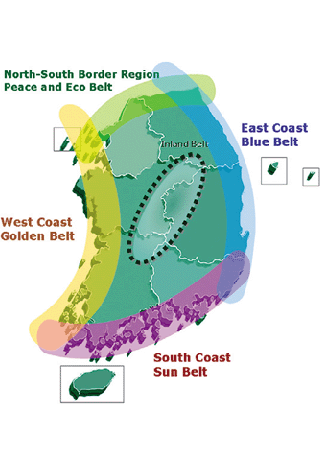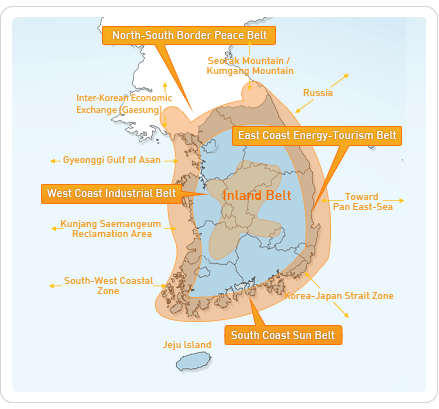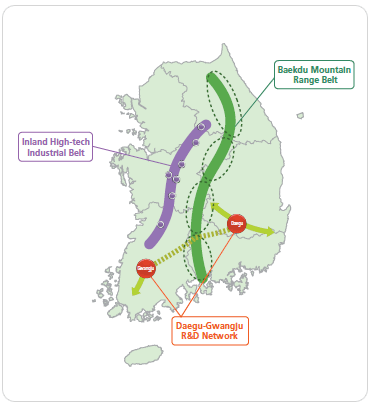Korea, open and expanding to the world
Korea will become more open to the world through the development of the four belts of South Coast, East Coast, West Coast and North-South Border Belts, along with the Inland Specialize Belt.

- To strengthen national competitiveness by connecting the territory to the world
Supra-economic Region is designated by the Presidential Decree, and intended to promote inter-regional and cooperative projects among Economic Regions, or with municipal governments in another Economic Region, targeting at regional competitiveness improvement.
Directions in Supra-economic Region Strategy
- To nurture cross-regional growth zones to lead national competitiveness enhancement and co-prosperity among regions in response to the era of globalization
- To envision new axes for territorial growth in order to enhance national competitiveness to compete in the world from a long range perspective, aiming to accommodate competition for place in east Asia
- To promote the development of east, west, north and south axes to counteract the Capital Region, based on which to overcome regional conflicts among Capital and non-Capital regions, and to facilitate linkage development among Economic Regions
- To designate cross-regional development regions centering around the four development axes while taking advantage of the geopolitical characteristics of the Korean Peninsula, and taking into account the inland axis as well
- In regard of the inland belts, the areas and development plans are scheduled to be confirmed under the collaboration among central PCRD and Economic Region Development Committees of each region.

01 To build a cross-border development base in northeast Asia
02 To create the territorial base in preparation for reunification on the Korean Peninsula
03 To establish cross-regional infrastructure and provide linkages among hub areas
04 To cultivate cross-regional growth engines and strengthen the network
05 To promote co-prosperity among regions based on common resources and cultures across the region
This strategy has two purposes: one is to deal with the global dimension of regional development in Korea, or a peninsular country in Northeast Asia; the other is to promote coordinated development between and among ERs.
The central government is currently working on the formulation of the "Comprehensive Plan" for the Supra-economic Regions. The draft plan was presented to the President in December 2009 with the final version expected to be completed in the near future.
Five policy tasks have been set forth to bring the Supra-economic Regions to fruition:
1) to establish a foundation for cross-border cooperation in Northeast Asia: the government will facilitate economic exchanges and cooperation between cities on the West Coast Rim, East Coast Rim, and Trans-Pacific Region;
2) to encourage a win-win development and functional connection within the Supra-economic Regions: the government will build interregional infrastructure networks including main transportation and logistics networks;
3) to foster world-class industrial clusters focusing on key manufacturing industries,
logistics, and green industries such as renewable energy;
4) to effectively utilize common natural resources, such as the Four Rivers, the Baekdu mountain range and historical cultural heritage sites: the government will launch cooperative regional development projects in the culture, tourism, and ecological sectors;
5) and to improve relations between North and South Korea, and to lay the spatial foundation for the reunification era by initiating exchanges and cooperative projects in the industry, tourism, ecological, and environment sectors in the border zones.

01 East Coast Energy & Tourism Industrial Belt
To develop a hub of new and renewable energy, tourism and leisure in the East Coast Rim
02 West Coast Industrial Belt
To foster industries including next-generation IT, automobiles and logistics in the West Coast Rim
03 South Coast Sun Belt
To nurture a hub for infrastructure industry, logistics, tourism and leisure to support the Pacific Rim
04 North-South Border Belt
To foster a central zone for environmental resources conservation and inter-Korean exchange
05 Inland Specialized Belt
To nurture specialized development hubs for a coast-inland connection










![[프로그램입력]](../../images/nav/nav_off_01.gif)
![[프로그램입력]](../../images/nav/nav_off_02.gif)
![[프로그램입력]](../../images/nav/nav_off_03.gif)
![[프로그램입력]](../../images/nav/nav_off_04.gif)
![[프로그램입력]](../../images/nav/nav_off_05.gif)








